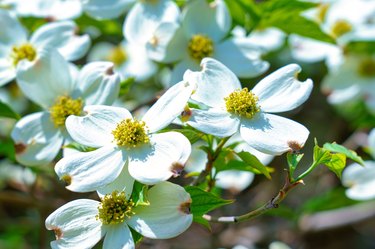
When most people think of New York State, they think of New York City. However, most of the Empire State is rural and forested, and boasts mountain ranges such as the Adirondacks, Berkshires and Catskills. These areas are home to around 180 native species of trees, some of which provide spectacular displays of flowers as well as resources for lumber, dyes, food and medicine. Many are sold commercially as ornamental native trees of New York.
Native New York Flowering Dogwood
Video of the Day
According to the Missouri Botanical Garden website, the flowering dogwood (Cornus florida, USDA hardiness zones 5 to 9) is renowned for its wide crown of showy pink and white spring blooms. Perhaps the most beautiful of pink and white flowering trees, it grows between 20 to 40 feet tall and produces red fruit and scarlet fall foliage. Its hard wood is used to make spools, pulleys, mallet heads and jeweler's blocks.
Video of the Day
The dogwood has purported medicinal value as well. Native Americans used the bark and roots as a malaria remedy, and its twigs were chewed to whiten teeth. During the Civil War, boiled dogwood bark was used as a substitute for quinine. The bark is also used to make dyes. The dogwood has a wide native distribution from Texas to Florida, and north to New York, Maine and parts of Canada.
Allegheny Shadblow Serviceberry
The Missouri Botanical Garden website notes that the Allegheny serviceberry (Amelanchier laevis, USDA hardiness zones 4 to 8), sometimes known as the shadblow serviceberry, is a small understory tree that can grow 20 feet or higher. It is native to the northeast and the Atlantic seaboard, ranging from Maine to New York to as far south as Georgia. It blooms long-petaled white flowers that are followed by small, red, apple-like edible fruit. It blooms between April and May.
The serviceberry, a member of the rose family, thrives in sunny or partially shaded wood-border areas, and prefers moist but well-drained soil. It's an important food plant for birds and other wildlife, but it is vulnerable to disease and insect problems. However, these are usually not life threatening and damage is usually just cosmetic. It's widely available as one of the ornamental flowering trees of New York State.
Common Fruiting Pawpaw
The common pawpaw (Asimina triloba, USDA hardiness zones 5 to 9) can grow as high as 40 feet and features large, tropical-like leaves, advises the Missouri Botanical Garden website. It blooms purple, six-petaled flowers that appear before the leaves do. Large, dark-green or yellow fruit follows, the smell of which can be overpowering when ripening. The fruit is edible, but should be eaten in small quantities, as it's been known to cause severe intestinal pain in some people.
This tree has a wide native distribution throughout much of the eastern United States, ranging from Texas to Florida up through Ohio, Pennsylvania, New York and parts of Canada. It attracts birds and butterflies, and small mammals enjoy noshing on the fruit. It has wide use as an ornamental tree.
Perennial Eastern Redbud
The redbud (Cercis canadensis, USDA hardiness zones 4 to 9) is perennial and a member of the pea family. According to the Missouri Botanical Garden website, it grows up to 30 feet tall and features pink flowers that bloom in the spring in an eye-catching display, which makes redbud a popular ornamental tree. There are three geographic varieties of redbud, with the eastern redbud being native to New York and surrounding states.
The buds and flowers are edible and can be used in salads, breads and pancakes. These have a sour taste and are high in vitamin C. Redbud trees prefer shady areas with moist, well-drained soil.